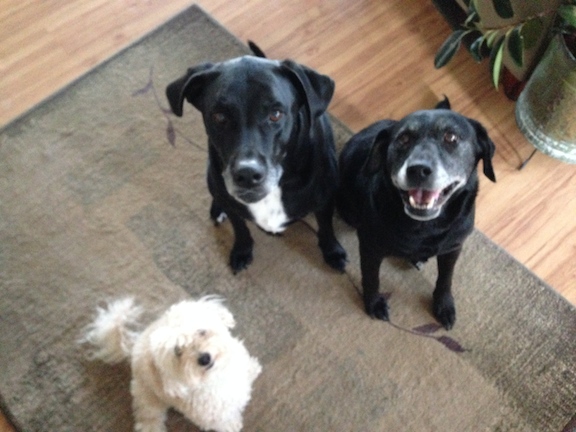Adding Rules and Boundaries to Help a Pack Learn to Listen and Behave Better
By: David Codr
Published Date: June 5, 2014
 I was called in to work with (clockwise from the white) Guy, Harley and Selkie. The primary concern was with Harley who had shown some light aggression and territoriality when new people come to the home.
I was called in to work with (clockwise from the white) Guy, Harley and Selkie. The primary concern was with Harley who had shown some light aggression and territoriality when new people come to the home.
When I arrived for the session, all three dogs came and greeted me at my car with some light barking. As their owners approached, I asked if this was a normal greeting and she said because I didn’t act afraid, this was a better greeting than most.
Its not uncommon for dogs to act more dominantly or aggressive when they sense another dog or person is afraid. This is why it important to never run away from a dog unless absolutely necessary (i.e. you are certain the dog wants to hurt you). So its important to remember to remain calm and confident when dealing with a dog and realize that we can change and effect a situation by how we react or interact with the dog.
Once I got inside I noticed that Harley went over to the kitchen table and took a seat underneath it. Combined with his history of aggressive behavior towards strangers, its a good bet that Harley is insecurely dominant. Because he had never bitten anyone, this is not an extreme case as is something that can be addressed by building up his confidence while also elevating the perceived authority of the humans in the home.
To address the leadership perception, I showed their owner an exercise I like because it teaches a dog to calm down, focus, see their human as an authority figure and practice self control.
Their owner nominated Guy to start with. At first Guy attempted to bypass the exercise, but I stayed with him and kept him in front of me until he finally gave up and laid down. Once he did, I gave him permission to get his reward – a juicy meat treat.
I repeated the process with Guy a few times and once he had it down, I walked his owners through the exercise until they got the same results. We repeated the process with Harley and Selkie who was the most challenging.
I suggested that they practice this exercise with each dog daily for the next week or two. The repetition will help the dogs gain confidence in the exercise. This confidence will be beneficial for Harley’s self esteem which should also impact his territorial display of aggression.
Next I went over a few different communication methods as well as some consequences to use when the dogs misbehaved, failed to listen or got over excited. Most dog problems are at their worst when they dog’s excitement level is high, so I like to use time outs when a dog gets past the middle of the acceptable levels of energy.
Because he didn’t always recall on command when outside, I suggested that Harley’s owners practice the recall exercise outside when the dog was close to the home. Because they live in the country, the dogs are exposed and interact with many different animals which can have an impact on their behavior.
By practicing the recall exercise as soon as the dog goes outside, and letting the dog continue outside, we can help Harley gain even more confidence as he masters the command.
By the end of the session, the dogs were calm, responsive and pooped. I advised their owner to be vigilant with the new rules and exercises over the next few weeks to really cement things in. These are intelligent dogs and responsible owners so I expect these behavioral changes will quickly become permanent.
Categorized in: Dog Behavior, Dog Psychology, Dog Training Omaha, Omaha dog training



